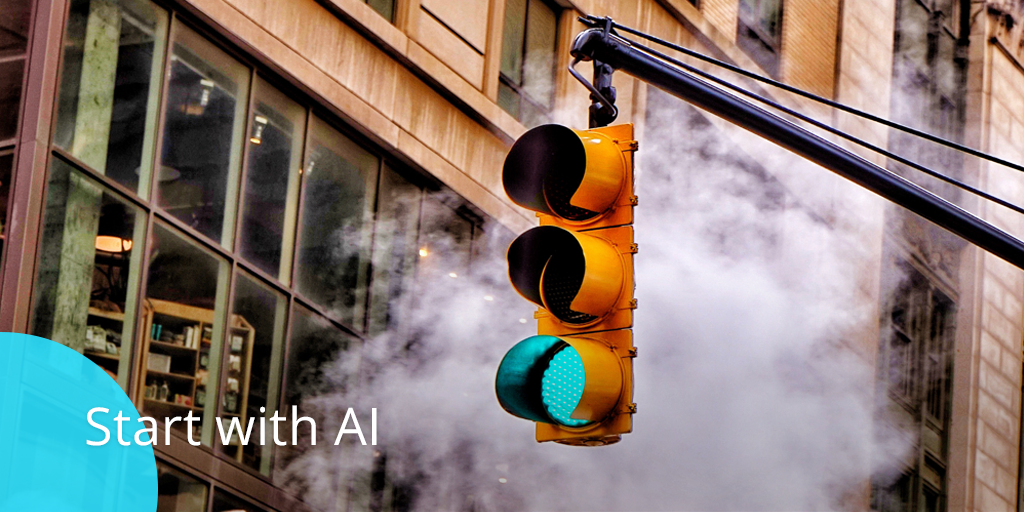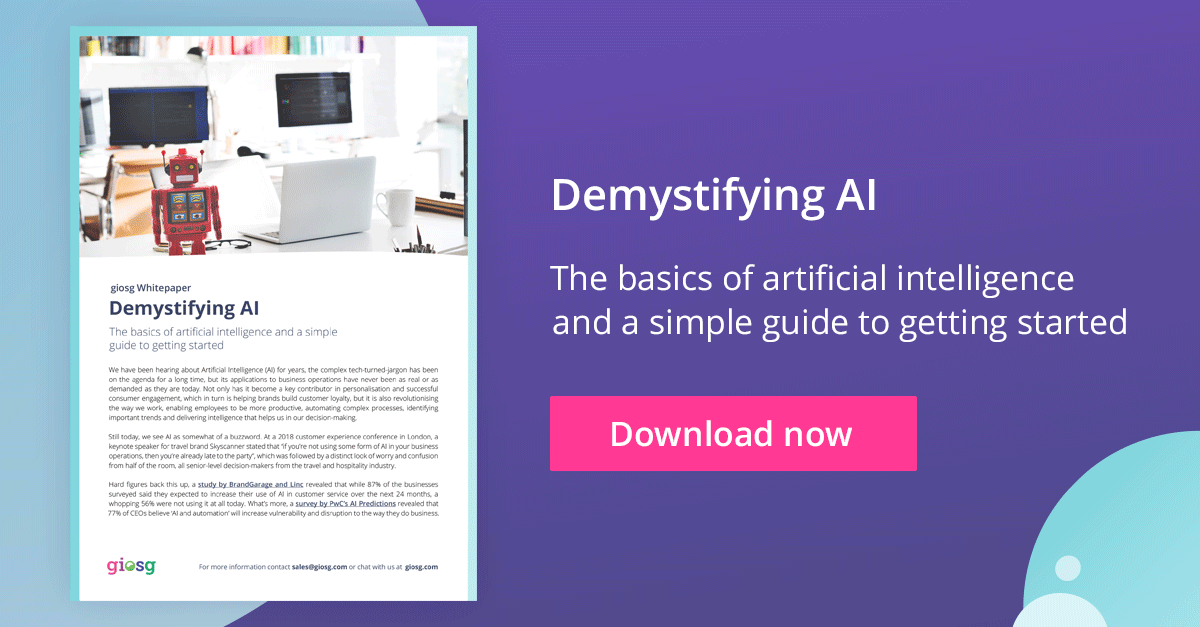“It's so simple and easy to use, it requires no IT or implementations to your systems, and when you think about a basic marketing budget - it costs mere pennies.” - Minsu Rauramo on AI at giosg
We conducted an interview with Minsu, our AI expert, to show you that implementing AI into your business can be a walk in the park. Whether you're a business owner, marketing or sales specialist - this blog aims to demystify AI by pulling back the curtain and providing you with practical insight to help you get started.

Should you develop your own AI or use a commercial solution?
Before deciding whether to develop your own AI or start using a commercial solution, there are some fundamental things to consider. Does AI bring value to you? Does it have the potential to increase conversion rates and customer satisfaction? Do you have the data to start creating models or do you have to gather the data first? If you want to create an in-house AI solution, you need the right environment for collecting, accessing and using data, as well as building hypotheses on inputs that may impact the different parts of the AI behavioural model. Before choosing to develop in-house, ask yourself whether you want to launch a huge IT project and whether you have the data required to solve things with AI in the first place.
AI is not a one-off implementation project but requires ongoing maintenance and consistent updating. If you have no experience building AI in-house, the easiest way forward is to choose a commercial solution. There are also hybrid solutions available, which offer different types of tools, for those looking for a starting point for developing their own AI model.
At giosg, we started building our own AI. It was the best and most logical solution as it allowed us to connect it directly with our other products, such as giosg Rules. Our business customers are looking to get better conversions through the use of our products which is why our machine-learning products are built especially to address that. AI is therefore a crucial part of our value proposition.
How do you spend your time with AI?
The majority of my time with AI is spent analysing customer cases and their data i.e. helping issues concerning conversions and identifying what their goals should be. Naturally, different customers need our help in different stages of the funnel, depending on where their bottleneck is. Discussing with customers about their goals and figuring out what they are truly after takes its own time - but we always manage to get there in the end. In the earlier stages of the funnel, you often get more conversions to the next step. This may not be the desired end goal, but sometimes it's necessary to get enough initial data for building the machine learning model.
A/B testing also takes some time to gather data into A/B testing groups. After the data is gathered, it is possible to go back and check the results. The A/B testing results either verify that your marketing campaign used in the test was worth targeting with Target or it may suggest trying another action or another goal. This model is based on behavioural data that our AI solution, giosg Target, collects from your website.
As a member of our AI Team, it's my job to get this insight from our customer cases and deliver it to our development and research teams.
What are some day-to-day things AI can help customers with?
AI can help with targeting costly marketing actions, especially when these marketing actions are not beneficial for conversion. When implemented properly, AI improves conversion and can add value to marketing activities that may not otherwise be executed. AI is resourceful and efficient - by using a machine learning solution, you can meet your business objectives with less work. In our case, AI improves chat quality which is something that our customers are often interested in.
What are some common AI issues that customers struggle with?
Cost can certainly be a challenge for some, especially when it comes to in-house AI development. Also, the general concept can be hard to grasp for many key decision-makers. They don't always know how to best utilise AI or take advantage of it.
Unfortunately, there is no one-size-fits-all approach to AI and the key benefits depend on the company at hand as well as their specific goals.
Because a lot of data is needed to build an adequate AI model, the issue often lies in the insufficient amount of data. Companies implementing AI must be patient and flexible - in the early stages of implementation it can take some time for the AI to work and deliver results due to a lack of data. Some desired goals or targets may even initially be out of reach. AI is not a magic tool - if there are no visitors on your website, tracking shopping cart conversions will not be possible.
People often expect immediate results, which AI can deliver but only after the data collection phase. To find the right strategy that works best for your business and customers, AI-powered marketing can and should be used for testing different actions - just like with any other marketing campaign. Some functions that you order AI to do will be successful and some will not. That's why it's crucial to test, modify, and implement.
What happens in practice if a customer wants to start using our AI, giosg Target?
It depends on the use case, but basically:
- We start by analysing the customer journey funnels the company is after.
- We then identify their goals. What is the goal they want to achieve? We set this goal into giosg settings.
- The goal is dependent on the use case and what it is that they want to optimise. It could be a marketing action, for example finding visitors who are not likely/likely to buy to whom we can then target a certain action. We work on this together with the customer, if they are unsure of what their goals are.
- Then, the giosg Target is given some time to learn the behavioural patterns of visitors.
- After some time, Target builds a model based on visitor behaviour/tracking, the goal, and the marketing actions. It continues to learn and improve the model as time passes.
- After these steps, the results are available in reporting and the customer can decide to make changes in the configurations if needed.
How long does it take to get Target functioning properly with enough data?
It takes 2 days to 4 weeks depending on the visitor activity, how often marketing actions are taken, and other actions we have decided to track.
How long does it usually take to see results?
After the learning period, the results are available right away. If the conversion rate is very low, the statistical “noise” requires more time to determine if the dips in conversions are because of AI or something else.
Our future plans with AI?
We plan to make our current optimisation tool more powerful within the next 5 years, providing better conversion rates. AI has great potential to optimise different types of business processes and their workflows, especially in sales and marketing.
Any last thoughts on AI?
Don’t be afraid of AI. It's so simple (at least our solution is), it requires no IT or implementations to your own systems, and when you think about a basic marketing budget - it costs mere pennies.” So if you want to increase conversion and already know where you want to better that conversion, consider AI - with the help of giosg of course.
You probably still got some questions about AI? Our whitepaper "Demystifying AI" can help you with that!
